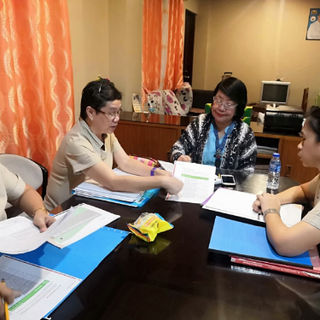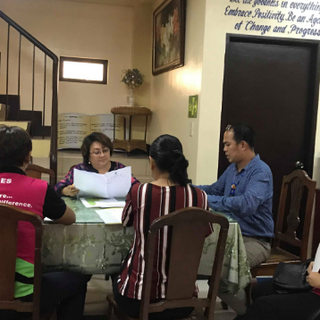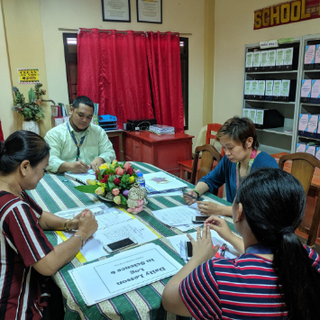Pilot run of STAR Patrol highlights commendable practices
- MS. MARNELLI B. TOLENTINO
- Jul 24, 2019
- 5 min read

“The experience is truly insightful. We are forced to reflect on our practices as instructional leaders and elevate the discourse to teaching standards found in the tools. We are happy that you chose us for this activity as the first recipients of relevant technical assistance,” said a grateful Ms. Marina F. Aunzo, principal of Nicanor Ibuna Elementary School (NIES), during the interview with the education program supervisors facilitated by the OIC-Superintendent Dr. Alejandro G. Ibañez and the OIC-Asst. Superintendent Mrs. Flordelisa D. Pereyra after the inaugural session of division STAR patrol project at her school.

Division STAR Patrol Project is a School-based Technical Assistance for Raters designed to monitor curriculum implementation as gleaned from Results-based Performance Management System (RPMS). It aims to gather first-hand information by the education supervisors as to how principals and master teachers (raters) process their observation notes to their classroom teacher (ratee) with the end view to craft the appropriate professional development plan. As process observers, they take note of gaps and the facilitation skills of the raters across the different phases of observation, from the pre-conference up to the post-conference.
“This project enables us to appreciate our roles as instructional leaders. It made us apply what we learned from the Instructional Leadership Program of the region and the recent seminar we had on Instructional LeaderSHIFT under our OIC-SDS Sir Al,” remarked Dr. Emma A. Sendiong, Values Education supervisor in a conversation with the Curriculum Chief Dr. Helen G. Padilla.

Moreover, this project allows the supervisors to monitor the implementation of the definitive budget of work, an offshoot of the region’s Learning Assurance Mapping Program (LAMP). “It also gives us the chance to see if teachers use the result of the functionality review we conducted for the supplementary materials procured by the local government,” added Math supervisor, Mrs. Helen S. Acedo.
In a separate occasion, Dr. Padilla reported the STAR Patrol project to the Regional Technical Assistance Group (RTAG) in a visit conducted last 3 July 2019 in this division. She narrated, “This project is a division initiative which forms part of our technical assistance in curriculum implementation. We target teachers who ranked the lowest in their performance rating so we can help the principals and master teachers in coming up with the appropriate supervisory plan that can help deliver improved teaching practices.”
Meanwhile, master teachers Mrs. Rizaly C. Bautista and Mrs. Mery Jean E. Devilleres of NIES who experienced the first STAR Patrol, commented, “We appreciate the list of protocols given and the guidance of our supervisors. It was hard at the beginning because it seemed that everybody was here to catch us with our shortcomings, like what we experienced before when we had the ADIS. But this time, it was different. It was more supportive and structured.”
ADIS or A Day In School, was a program in the past where supervisors of various learning areas visit a particular school and simultaneously observe classes and hold post-conferences. It apparently left a negative impression to teachers which looked at the activity as more intrusive rather than helpful to their careers.

In comparison, STAR Patrol is designed to capture the interface of the supervisors with the raters in the schools under the rubrics of the Classroom Observation Tools (COT) of the RPMS. It also forms part of the required number of observations to be met in a quarter by the school heads. It mattered that prior to its pilot run, the OIC-superintendent and his assistant consulted with the school heads, supervisors, and members of teachers’ organizations, to flesh out insights that leveled the expectations in the field and clarified the objectives of the project.
“STAR Patrol is a project that looks into the roles of instructional leaders in faculty development more than pinning down the weaknesses of observed teachers. It dwells on drawing support packages to the teachers that can help improve learning delivery, from one observation period to another. It is developmental so you don’t need to cover a number of teachers, just the priority ones. Once there’s a substantial change in their menu of teaching practices, then you’ll know that the star has shone bright in them,” explained the brilliant Dr. Ibañez during their staff meeting.
In the debriefing that happened after the initial conduct of STAR Patrol at NIES, supervisors reviewed what went well and what needed modifications. When asked how the team can further improve its implementation, principal Ms. Aunzo replied, “Perhaps time should be managed during deliberations. Raters need also to be mindful of their discussion especially so when there’s another observation scheduled for the day.”
STAR Patrol Project kicked off with a promising start. The rest of the schools followed suit as seen in the photo essay below. Congratulations!
S A N J U A N N A T I O N A L H I G H S C H O O L – J U N I O R H I G H S C H O O L
P E D R O C R U Z E L E M E N T A R Y S C H O O L
S A N J U A N N A T I O N A L H I G H S C H O O L – S H S ( A C A D E M I C )
S A N J U A N N A T I O N A L H I G H S C H O O L – S H S ( T E C H V O C )
P I N A G L A B A N A N E L E M E N T A R Y S C H O O L
K A B A Y A N A N E L E M E N T A R Y S C H O O L
S A L A P A N E L E M E N T A R Y S C H O O L
S A N J U A N E L E M E N T A R Y S C H O O L
S T A. L U C I A E L E M E N T A R Y S C H O O L
S A N P E R F E C T O E L E M E N T A R Y S C H O O L
S A N J U A N C I T Y S C I E N C E H I G H S C H O O L
Article written by:
Marnelli B. Tolentino (Education Program Supervisor - English)















































































Comments